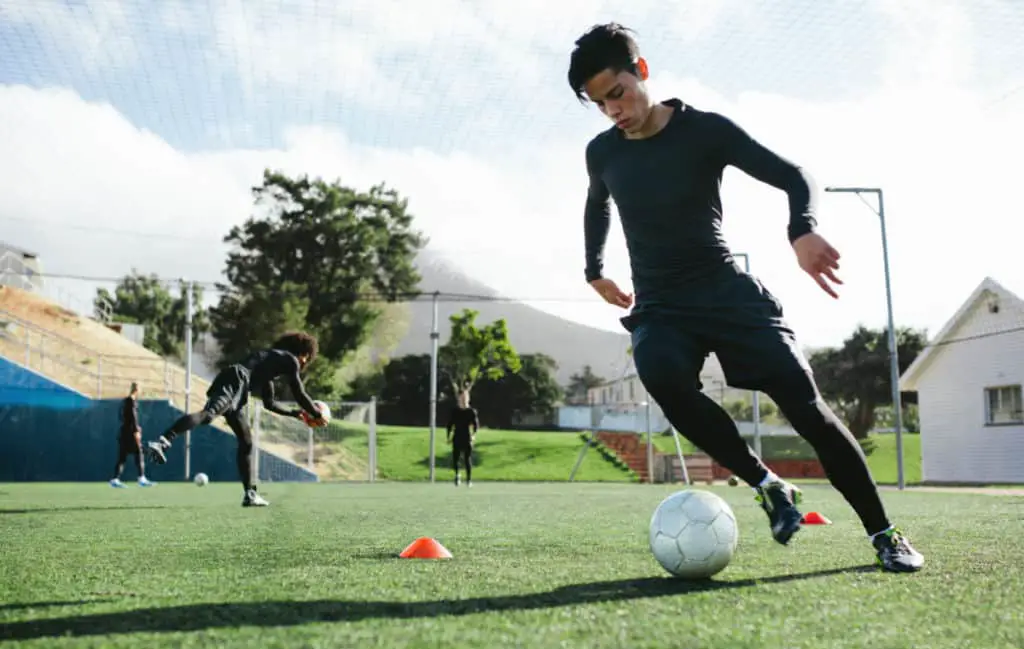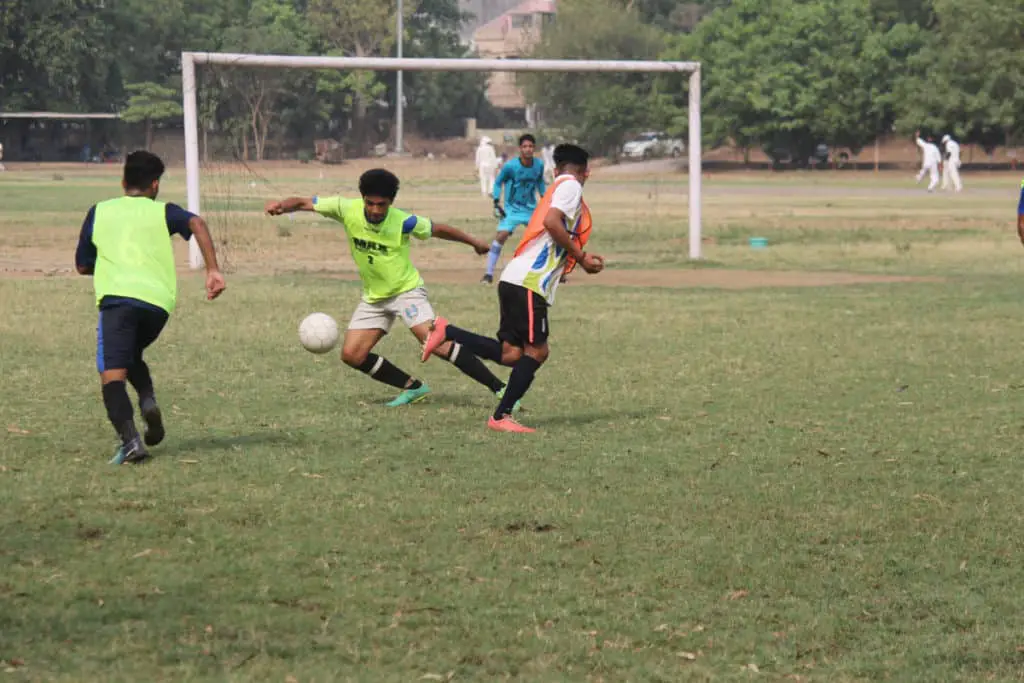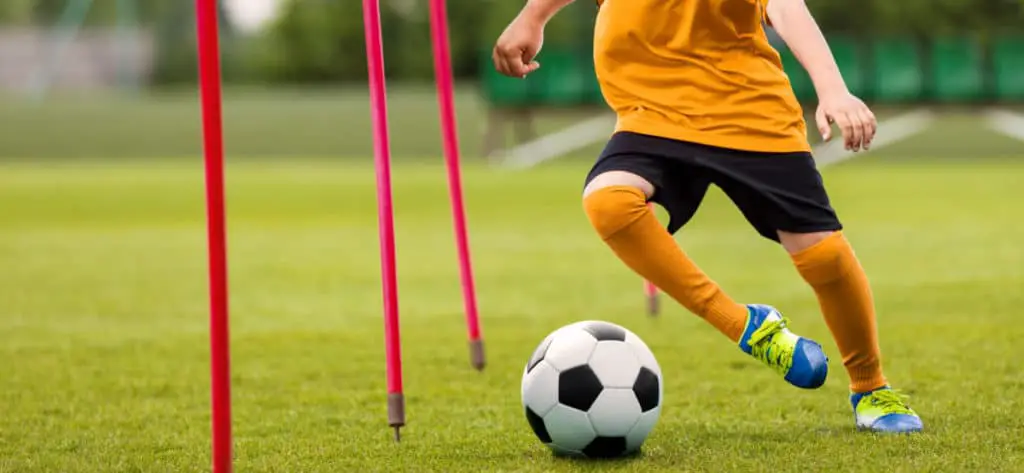Soccer is a great sport for people of all ages. Many enjoy playing the game, while others are simply fans of the game that love to watch a game. Soccer is highly entertaining and full of action.
Some might complain that there are not enough goals scored, but the reality is that the action in a soccer game is quite impressive and highly entertaining. There are very few breaks in action, in fact halftime is the only time the games stops outside of an injury or a goal.
The more you know about the game and the little intricacies taking place in strategy, the more you might enjoy watching soccer. Below we answer some of the more basic questions related to soccer and provide a complete guide to help you enjoy the game more.
The World Cup, which takes place every four years, is always a highlight with our family. The games are constantly on the television and we are taking in every game. The entertainment value is high.
We also spend most weekends at a field throughout the year with club soccer or travel soccer. We have been highly involved in the game and learned to love it more and more with each year. Having played soccer as a kid, it was a blast back then and now coaching and supporting our kids in their journey has reconnected us with the great game of soccer.

How Many Soccer Players on the Field
Only a maximum of 11 players are allowed on the field during the game. In soccer terms this would be called 11v11. At the professional level, 3 substitutions are allowed throughout the course of the game. In many youth leagues, the number of players on the field will vary with each age group and substitutions are typically allowed more frequently. Most teams will have an additional 3 to 12 players to choose from for their substitutions.
Below we will provide a complete overview of how many players are allowed on a field at each age group and the number of substitutions.
Table of Contents Include:
- How Many Soccer Players on the Field – Youth Soccer (Chart Included)
- Formations in 7 v 7 Soccer (Chart Included)
- Formations in 9 v 9 Soccer (Chart Included)
- What Are the Keys to Success in Coaching Soccer?
- Soccer Passing Drills for Your Team
- Have Fun Coaching and Play Soccer
- Small Sided Games and Benefits
- Take Action
- Recommended Gear
How Many Soccer Players on the Field – Youth Soccer
The answer to this question is complicated as it varies by age group. One of the things we appreciate about soccer is the willingness to adjust the size of the field and the number of players on the field to bring the quality of the game up depending on the expected skill level for that age group. In too many other sports, games are played on too big of a field with too much space, which reduces the quality of the game and the opportunity for skill development. Soccer uses the birth year of a player to determine the age group the kid can play in.
You will see a term such as 8u, which means kids 8 and under can play in that division. Having coached at multiple levels below, I believe that these numbers and adjustments have been set up near perfect for the age, size and skill at each level. It provides a quality opportunity for kids to develop the proper skills at the proper times. It also keeps the game fun for the kids involved and encourages them to return to the game the following season.
Breakdown of Soccer Players on the Field by Age Group
| Age Group | # of Players | Ball Size | Game Length |
| 6U, 7U, 8U | 4 v 4: no goalkeepers | #3 | 4 – 10’ quarters |
| 9U & 10U | 7 v 7 | #4 | Two 25’ halves |
| 11U & 12U | 9 v 9 | #4 | Two 30’ halves |
| 13U & 14U | 11 v 11 | #5 | Two 35’ halves |
| 15U & 16U | 11 v 11 | #5 | Two 40’ halves |
| 17U, 18U, 19U | 11 v 11 | #5 | Two 45’ halves |
Formations in 7 v 7 Soccer
If you are coaching a youth soccer team and your league is playing a 7 v 7 format, you have several different options for your formations. You must assess the strengths and weaknesses of the team and try to put players in a position where they can experience some success.
Keep in mind that you still want to help players fully develop and at a younger age, you might decide to play the players in all of the positions to increase the exposure to the different opportunities. Once you settle in on a formation, help you players understand the roles and responsibilities of each position.
Don’t forget to keep practicing passing drills and helping players increase their field awareness and the proper movements to create passing lanes.
Quick Note: Formations are explained from front to back, starting with the defenders and moving to your attackers.
| Formation | Pros | Cons |
| 2-3-1 | Solid defensive and midfield support. | Could leave the striker as only person attacking if defenders get caught back. |
| 3-2-1 | A more defensive strategy with 3 defenders in place. | Could leave middle of the field open with only 2 midfielders and could leave the offensive side weak. |
| 2-2-2 | Clear defined roles with the three different groups. Players can make runs. | Could lack width in this formation. Players need to cover for each other |
| 1-4-1 | If you have a strong 4 midfielders it provides them with versatility to dominate the middle of the field. | Weak on the defensive side of the ball with only 1 defender back. Relies heavily on midfielders to play boths sides of the ball. |
| 4-1-1 | Very strong defensively. Gives your 2 outside defenders an opportunity to make an offensive run. | Could be weak on the offensive end if the defenders can’t make the offensive run. |
Coaches Recommendation for 7 v 7
We prefer the 2-3-1 at this age level. We are able to take one fast defender and match that player up with a weaker defender. Also, the 3 midfields must be able to work together and use the striker to form triangles and passing opportunities. If a team is really pushing their defenders up, it leaves great through balls for the striker and opportunities to score. You want to put your strongest players at midfield and have them feed the striker and support on defense.

Formations in 9 v 9 Soccer
Now that you have stepped up a level from 7 v 7, the players are older and can probably make longer passes and have stronger legs. If some have been playing or multiple years they may be better with the footwork and can beat a player or two off the dribble and provides some attacking opportunities. Here is another chart on formation options for a 9 v 9 setup.
| Formation | Pros | Cons |
| 3-3-2 | Balanced field with strong defense and strong support in the middle. | Leaves the offensive side a little light. Midfielders must be in a position to attack. |
| 2-3-3 | Strong offensive possibilities. Can help keep the ball on the offensive side of the field with players that can control the ball. | Weak on the defensive end with only 2 defenders. If fast and athletic they may be able to handle it. |
| 2-4-2 | Very strong in the middle and two outside midfielders can make solid runs. Midfielders must work together. | Could leave the team vulnerable offensively and defensively if midfielders are unable to make solid runs. |
| 4-4 | Clear defined lines and roles. The 4 by 4 is unconventional, but helps players work together. | If player don’t work together and adjust for those making runs, you could have big gaps in your spacing. |
Coaches Recommendation for 9 v 9
We would recommend the 3-3-2. The key here is a strong defense and having them push up to keep the ball on the offensive side of the field. The 2 offensive players must move around and find the open spaces. Sometimes, they can get caught watching and clog up the middle of the field. When we see this happening, we can go to a 4-4 with our less experienced teams, with your more experienced teams that do not have many weak sports, the 3-3-2 has give us a lot of success.
What Are the Keys to Success in Coaching Soccer?
Tip #1 – Stay Calm
Players learn best from instruction and not yelling. If a kid is struggling for the kid aside and explain further. Oftentimes our lack of success as coaches is from lack of clarity. Players must have confidence in us, feel a connection and know we have their best interest at heart. On top of all of that we must be able to provide clarity in roles and expectations on the style of play. If a player has doubt in their mind, they will be slow to move and be hesitant.
Tip #2 – Practice Footwork
With all of the different formation possibilities, we can get stuck instructing strategy instead of developing skill. Soccer is a highly skilled game that requires players to continue to develop their footwork. If your players have great footwork, they can adjust to any formation you throw at them as long as they have some clarity. At least half the practice should be footwork and passing drills. Don’t get caught in the trap of explaining everything and instead model, demonstrate and point out the small tips to help players get better.
Tip #3 – Constantly Teach
Players need to learn, you need to stay calm and help them learn. The coach that views themselves as a teacher will have the most success. Soccer is a difficult game and takes an encouraging person that is going to provide feedback on improvement areas and give feedback in small chunks. Highlight the successes and give tips to help for improvement. Make sure not to overload the feedback and know where each kid is at in his or her development.

Soccer Passing Drills for Your Team
We believe that in soccer we must spend a lot of time on footwork and passing drills. Having the proper equipment such as cones and a ball for every player is essential.
Encourage each kid on your team to have their own ball, this comes in handy at each practice and provides players with a ball to practice between practices. Soccer is a highly skilled game and to get to an elite level as a player, he or she must have a ball on their foot a high percentage of the time.
The great thing about today’s coaching is that we have access to some of the best instructional videos and ideas that we can utilize in our practice. Find which your 5-10 go to drills and use these at most practices. Properly instructor the finer points of the drills and make sure you have points of emphasis.
This common language and points of emphasis will carry over and players will start to speak your language and know what is important. You will see them develop quickly with these points of emphasis for each drill.
Here is a video with 10 impressive passing drills:
Here are some great footwork drills. Remember: have every player bring a soccer ball to practice:
Have Fun Coaching and Playing Soccer!
Coaching and playing soccer should be enjoyable. Have a goal of making practice fun and full of energy. Remember the goal should be that each kid wants to play again next season. Help them reach their full potential through fun drills and mini competitions. Have them complete with their personal best and the best amongst the team.
Small Sided Games Benefits
Small sided games are when you have less that the number of players typically on the field. In many small sided games you will see a 4 v 4 setup on a condensed field or even a 4 v 2 to work on different passing drills.
Our recent learning in many sports continues to show the importance of small sided games. There are many benefits to small sided games. Too many coaches default to scrimmaging with 9 v 9 and the touches are limited and the time is not fully maximized. Here are some of the benefits of small sided games in soccer: More touches for each player
- Learning to work in small spaces
- Competition friendly
- Great instruction opportunities
Here is a video on small sided games in soccer:
Take Action…
Soccer is a wonderful game. It can be enjoyed by people of all ages. As a player and coach that loves the game, one of our missions is to ensure kids get involved in sports and stay involved. There are many lifelong benefits of playing sports as a kid and then staying with some activity into adulthood.
The life lessons that can be learned and the personal development that can take place through sports is phenomenal and something we truly value at sportwarrior365. Whether you are a fan, player, coach or parent, find a way to give back to the game and keep the right attitude on and off the field.
Recommended Gear
Here are some products that we have used in coaching of soccer that might be beneficial for you as a coach or for your player as a parent. Cones, soccer balls and pop up goals are essentials for the practice field or to help your kid get better at home.
